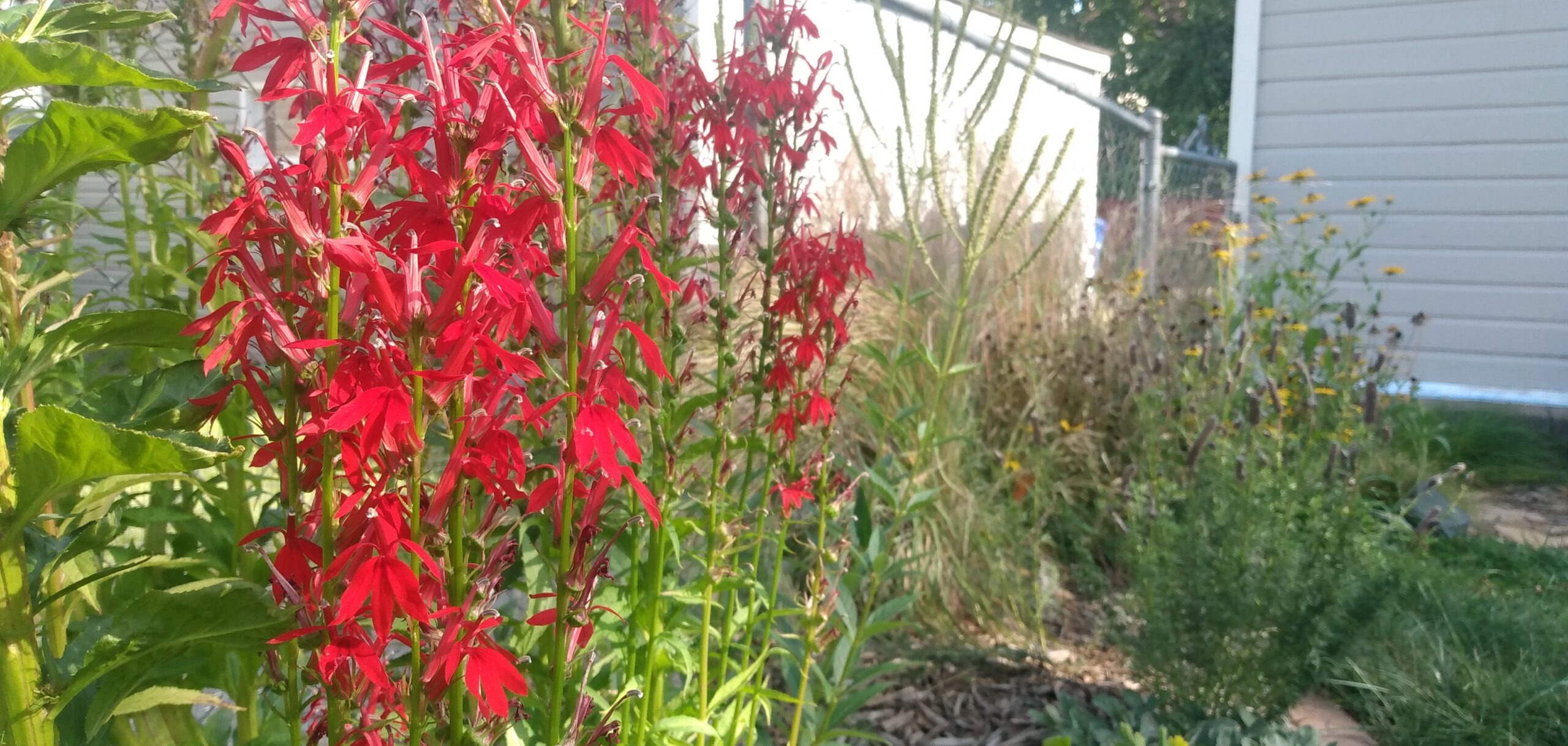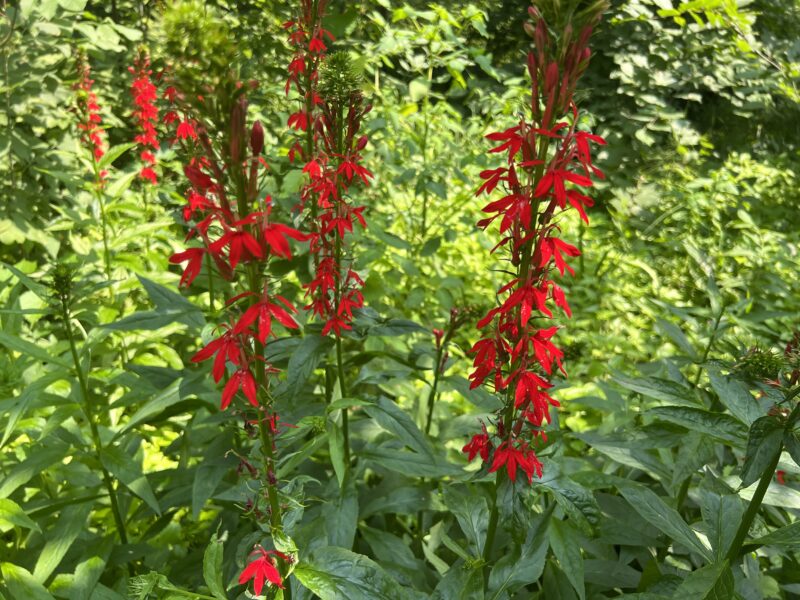
Guest writer Nick Voss, Education & Outreach Coordinator with VLAWMO, contemplates what the relationship between the cardinal flower and ruby-throated hummingbird can teach us about connection and perseverance through the challenges of environmental stewardship.
The cardinal flower and the ruby-throated hummingbird share something special. Some know it as symbiosis, others by reciprocity, and others might even say it reflects the human pursuit of connection.
Cardinal flower is a Minnesota native plant that prefers rich, moist to wet soil. A member of the Bluebell family, it’s often found near water or in wet meadows and prairies. True to its namesake, it has bright fire engine-red flowers that bloom from July to September.
Consistently wet spots can be a challenge for gardening, but cardinal flower is an example that there’s a plant for any setting. Gardeners can even bend a stem down to the ground and hold it there with a rock, and the plant will propagate anew. As an added bonus, it’s moderately deer resistant. Some butterflies will feed on cardinal flower nectar, but butterflies don’t successfully pollinate the flowers. Cardinal flowers are adapted to be pollinated exclusively by hummingbirds.
In the Midwest and Eastern US, this is the ruby-throated hummingbird. Known colloquially by bird enthusiasts as “hummers, they’re agile flyers that can fly up, down, side-to-side, and backwards while stopping and turning on a dime. The ruby-throated hummingbird is the only hummingbird native to Minnesota, beating its wings 53 times per second while weighing in at a whopping .2 ounces.
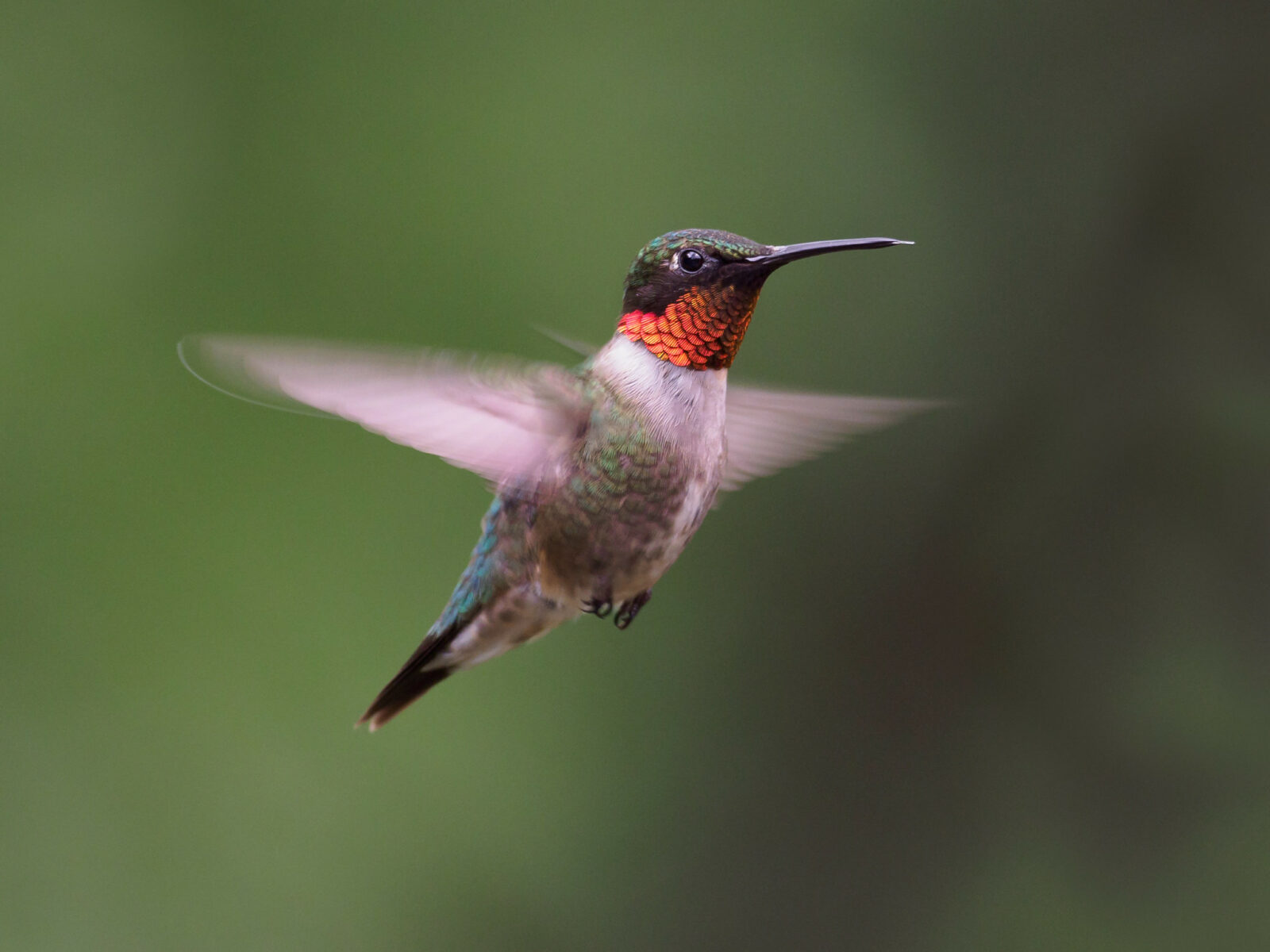
Despite being tiny, ruby-throated hummingbirds have quite the voracious diet. With their nimble flight skills they can pick mosquitoes, gnats, and small bees right out of the air, glean aphids or small caterpillars off of leaves, and snatch spiders from their webs. Tubular flowers with nectar are their specialty, but to mix things up they can also dine on tree sap. Some common flowers that ruby-throated hummingbirds frequent include jewelweed, morning glory, beebalm, honeysuckle, and of course cardinal flowers. Bright colored flowers are a good indicator of a potential snack, as hummingbirds have a good sense of color and can see into the ultraviolet spectrum.
Hummingbirds need their fuel. Many ruby-throated hummingbirds migrate to central and south America during the northern hemisphere’s winter, often making the epic haul over the Gulf of Mexico in a single flight. Across the world, hummingbirds appear in countless folk tales and legends thanks to their reputation of being small yet persistent in the face of challenge and adversity.
A Lifetime of Flower Visits
When reflecting on persistence, I’m struck by the many examples I’ve seen working in the field of water and natural resources as a Blue Thumb partner. Many days feel like an uphill battle as species become endangered, water bodies get listed as impaired, and wetlands suffer with pollutants. Yet like hummingbirds staff, partners and public supporters show up to network, plan, and plant.
As a public employee for several years, I’ve been able to glimpse the human condition through a variety of projects and partnerships. Volunteers come and go, mentored students complete their science fair project and go to college, and you never know who will walk up to an education table at a summer town event.
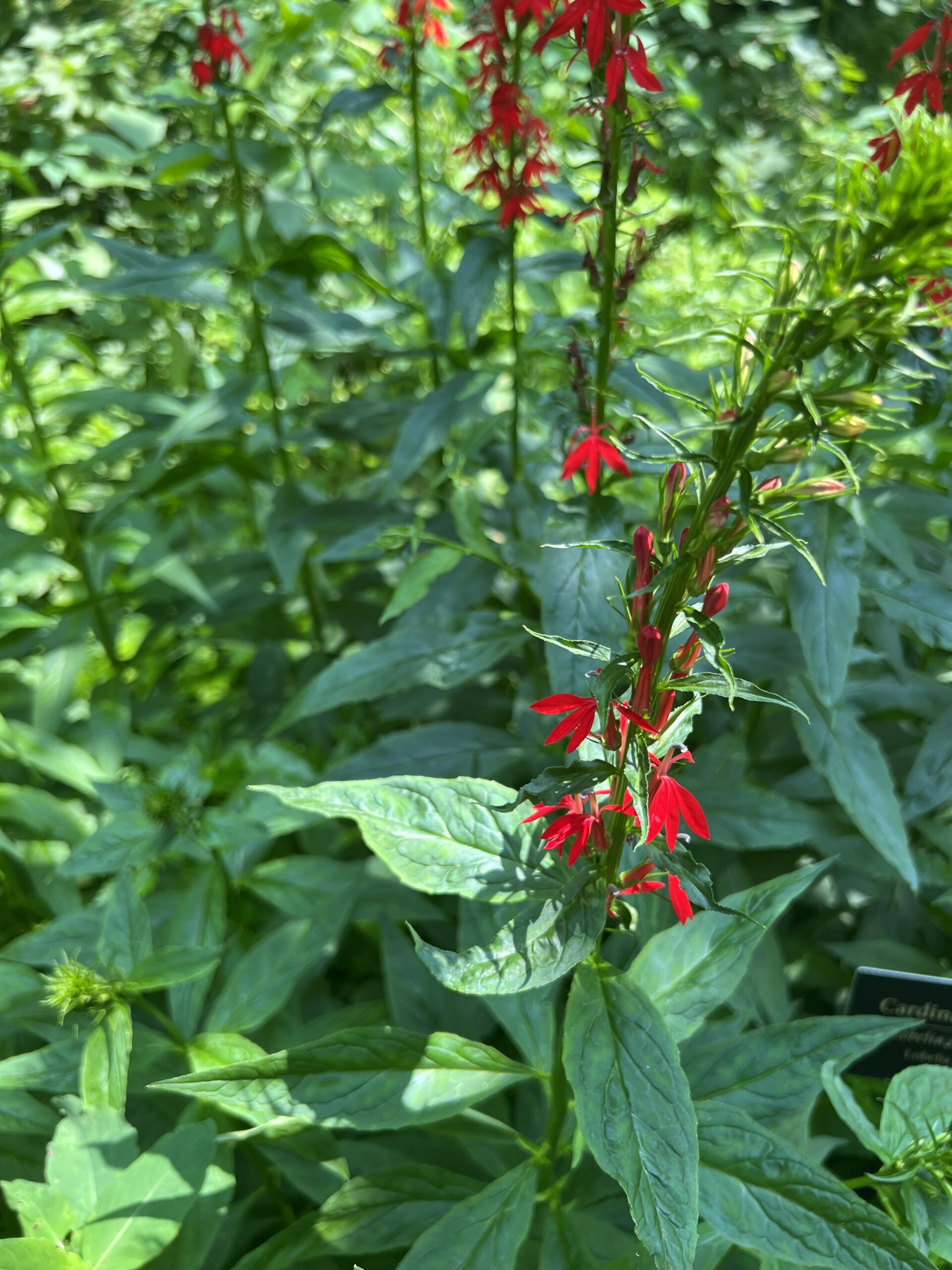
A man named Rob once served on two public commissions and was an active watershed volunteer. A US veteran, he was one of the most dedicated volunteers and always said “team work makes the dream work” with a gusto that cleared away any doubts you may or may not have known you even had. His joyful meeting and volunteer routine would have kept going, but over the course of a year his appearances gradually grew sparse due to early onset dementia. On his last public meeting his whole family proudly attended, filling the council chamber with applause, photos, and cheers.
In another encounter, I was able to work with a County sentence-to-serve crew with enough frequency to get to know a few of the inmates. While I initially had some apprehension, I was taken aback by the generosity and enthusiasm of the crew. The hope of a second chance was much more than showing up to work. The crew leader known as “Mama Bear” had a stern but compassionate presence, an instant authority despite a short stature, marked by stories written on her face. They had a full family with characters, inside jokes, and a sense of belonging. Over lunch a guy told me about his vision to complete his service, unite with his family, and start a new career. The next year when the crew came, Mama Bear informed me he had done it, plus stayed active as a volunteer in his community.
For those who work with and know wetlands, brokenness and lack of connection is everywhere we look. Beside the freeway are dozens of wetlands, no cardinal flowers to be seen. But their seeds are waiting. At Blaine wetland Sanctuary, a restoration effort has revealed that native and rare seeds were still viable for decades if not longer once they were uncovered. After stewards scraped off the layers of sediment and removed the cattail and reed canary grass, sundews started to grow again.
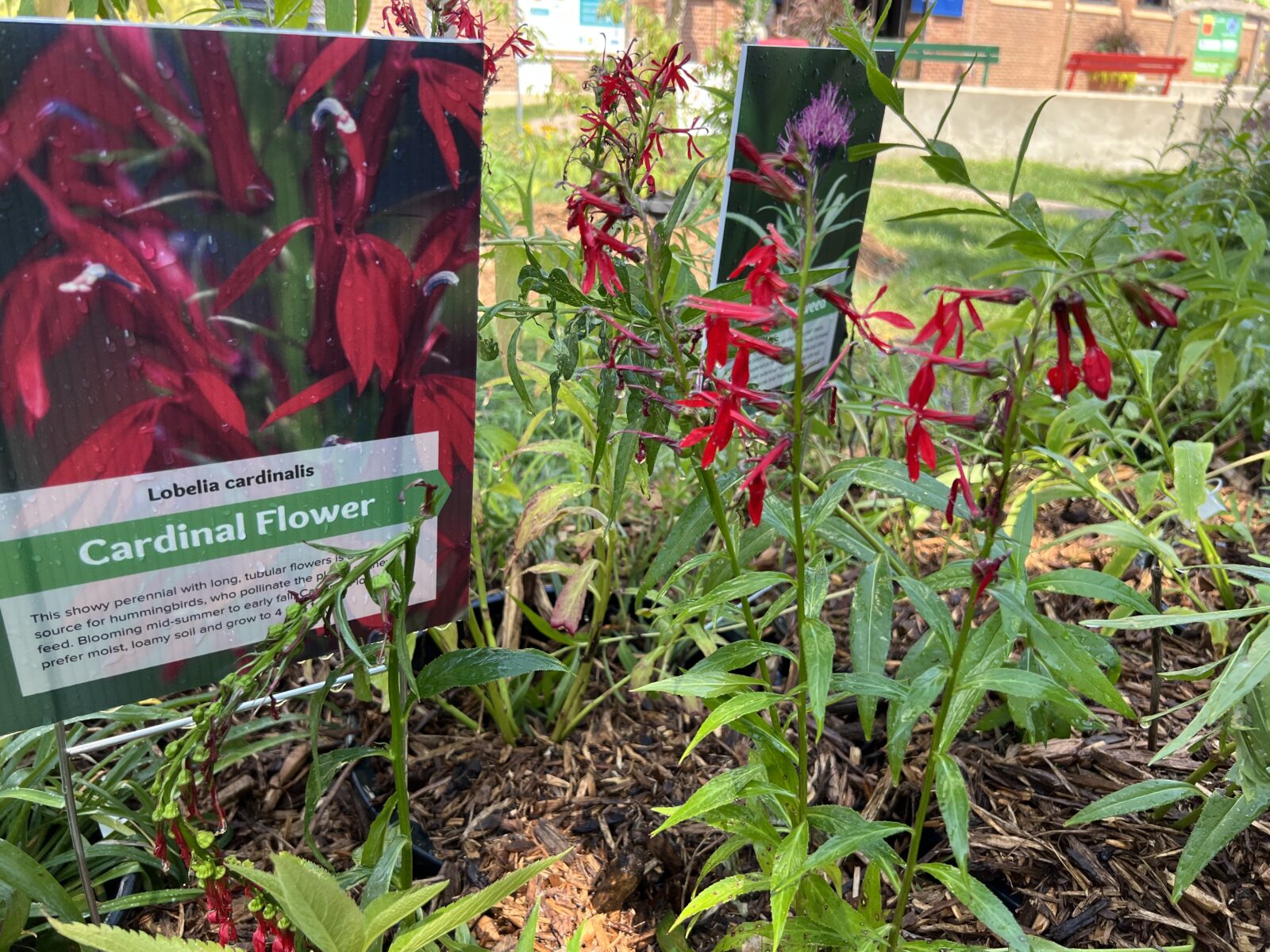
Stories of connection and restoration aren’t always charismatic and may even be drab and boring. A single visit by a hummingbird to a cardinal flower takes a few mere moments, and most of the time no one was around to see it. But from a certain perspective, that one fleeting moment was part of a continual chain, where one moment was really thousands.
How has the cardinal flower developed its tubular shape? How have some plants grown thorns while some have elected to be digested or even scorched to bear its offspring? In “Becoming Animal,” David Abram describes the way matter is always conversing with itself. Like a canoe paddle gently worn down by hands paddling, there’s a conversation happening right under our noses. In the tropics the game of chase between hummingbird bills and flower sepals has resulted in longer and longer tubular flowers with elaborate curves and pollinator specialists.
“Our nervous systems are wholly informed by the particular gravity of this sphere, by the way the sun’s light filters down through Earth’s atmosphere, and by the cyclical tug of the Earth’s moon. In a thoroughly palpable sense, we are born of this planet, our attentive bodies coevolved in rich and intimate rapport with the other bodily forms – animals, plants, mountains, rivers – that compose the shifting flesh of this breathing world.”
From this perspective, connection starts right here in the attentive body. Our most precious moments flit between our many distractions and back-shelf stresses that steal us away. But we’re agile, persistent, small yet powerful. Like plants we shuffle between yeses and no’s, a dance of consensus and everyone finding their right place to complete the task. Perhaps one work meeting ending with consensus, one youth completing their science fair project, a simple “gesundheit” at the office, are all fleeting but unbroken chains of moments, bearing the weight of thousands. Like the saga between the hummingbird and the cardinal flower, one small story of connection is a thread in the multitude of flower visits.
See cardinal flowers blooming at the Minnesota State Fair! Visit Blue Thumb outside the Eco Experience Building through Labor Day.
